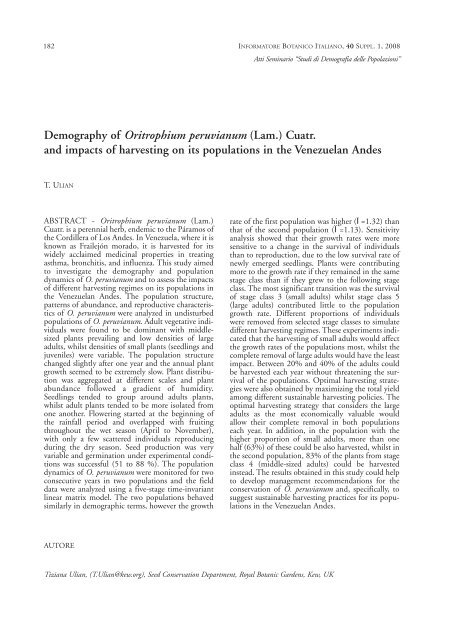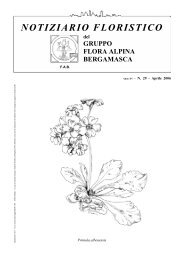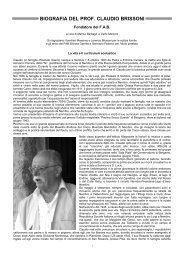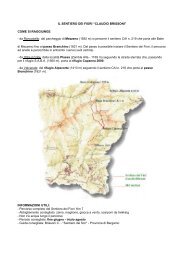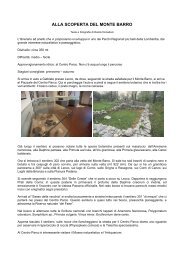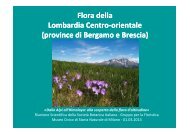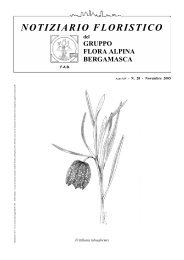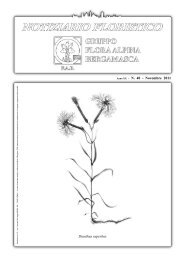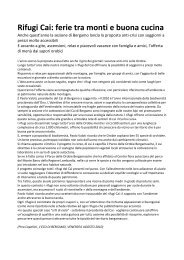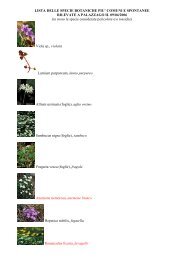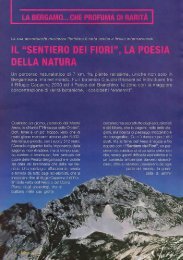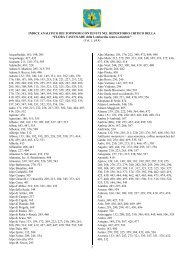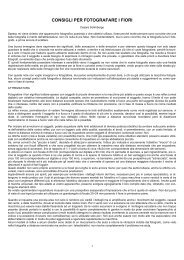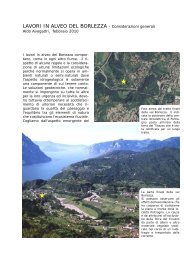IBI 40 Supplemento 1 (2008) - Gruppo Flora Alpina Bergamasca
IBI 40 Supplemento 1 (2008) - Gruppo Flora Alpina Bergamasca
IBI 40 Supplemento 1 (2008) - Gruppo Flora Alpina Bergamasca
You also want an ePaper? Increase the reach of your titles
YUMPU automatically turns print PDFs into web optimized ePapers that Google loves.
182 INFORMATORE BOTANICO ITALIANO, <strong>40</strong> SUPPL. 1, <strong>2008</strong><br />
Atti Seminario “Studi di Demografia delle Popolazioni”<br />
Demography of Oritrophium peruvianum (Lam.) Cuatr.<br />
and impacts of harvesting on its populations in the Venezuelan Andes<br />
T. ULIAN<br />
ABSTRACT - Oritrophium peruvianum (Lam.)<br />
Cuatr. is a perennial herb, endemic to the Páramos of<br />
the Cordillera of Los Andes. In Venezuela, where it is<br />
known as Frailejón morado, it is harvested for its<br />
widely acclaimed medicinal properties in treating<br />
asthma, bronchitis, and influenza. This study aimed<br />
to investigate the demography and population<br />
dynamics of O. peruvianum and to assess the impacts<br />
of different harvesting regimes on its populations in<br />
the Venezuelan Andes. The population structure,<br />
patterns of abundance, and reproductive characteristics<br />
of O. peruvianum were analyzed in undisturbed<br />
populations of O. peruvianum. Adult vegetative individuals<br />
were found to be dominant with middlesized<br />
plants prevailing and low densities of large<br />
adults, whilst densities of small plants (seedlings and<br />
juveniles) were variable. The population structure<br />
changed slightly after one year and the annual plant<br />
growth seemed to be extremely slow. Plant distribution<br />
was aggregated at different scales and plant<br />
abundance followed a gradient of humidity.<br />
Seedlings tended to group around adults plants,<br />
whilst adult plants tended to be more isolated from<br />
one another. Flowering started at the beginning of<br />
the rainfall period and overlapped with fruiting<br />
throughout the wet season (April to November),<br />
with only a few scattered individuals reproducing<br />
during the dry season. Seed production was very<br />
variable and germination under experimental conditions<br />
was successful (51 to 88 %). The population<br />
dynamics of O. peruvianum were monitored for two<br />
consecutive years in two populations and the field<br />
data were analyzed using a five-stage time-invariant<br />
linear matrix model. The two populations behaved<br />
similarly in demographic terms, however the growth<br />
rate of the first population was higher (Ï =1.32) than<br />
that of the second population (Ï =1.13). Sensitivity<br />
analysis showed that their growth rates were more<br />
sensitive to a change in the survival of individuals<br />
than to reproduction, due to the low survival rate of<br />
newly emerged seedlings. Plants were contributing<br />
more to the growth rate if they remained in the same<br />
stage class than if they grew to the following stage<br />
class. The most significant transition was the survival<br />
of stage class 3 (small adults) whilst stage class 5<br />
(large adults) contributed little to the population<br />
growth rate. Different proportions of individuals<br />
were removed from selected stage classes to simulate<br />
different harvesting regimes. These experiments indicated<br />
that the harvesting of small adults would affect<br />
the growth rates of the populations most, whilst the<br />
complete removal of large adults would have the least<br />
impact. Between 20% and <strong>40</strong>% of the adults could<br />
be harvested each year without threatening the survival<br />
of the populations. Optimal harvesting strategies<br />
were also obtained by maximizing the total yield<br />
among different sustainable harvesting policies. The<br />
optimal harvesting strategy that considers the large<br />
adults as the most economically valuable would<br />
allow their complete removal in both populations<br />
each year. In addition, in the population with the<br />
higher proportion of small adults, more than one<br />
half (63%) of these could be also harvested, whilst in<br />
the second population, 83% of the plants from stage<br />
class 4 (middle-sized adults) could be harvested<br />
instead. The results obtained in this study could help<br />
to develop management recommendations for the<br />
conservation of O. peruvianum and, specifically, to<br />
suggest sustainable harvesting practices for its populations<br />
in the Venezuelan Andes.<br />
AUTORE<br />
Tiziana Ulian, (T.Ulian@kew.org), Seed Conservation Department, Royal Botanic Gardens, Kew, UK


